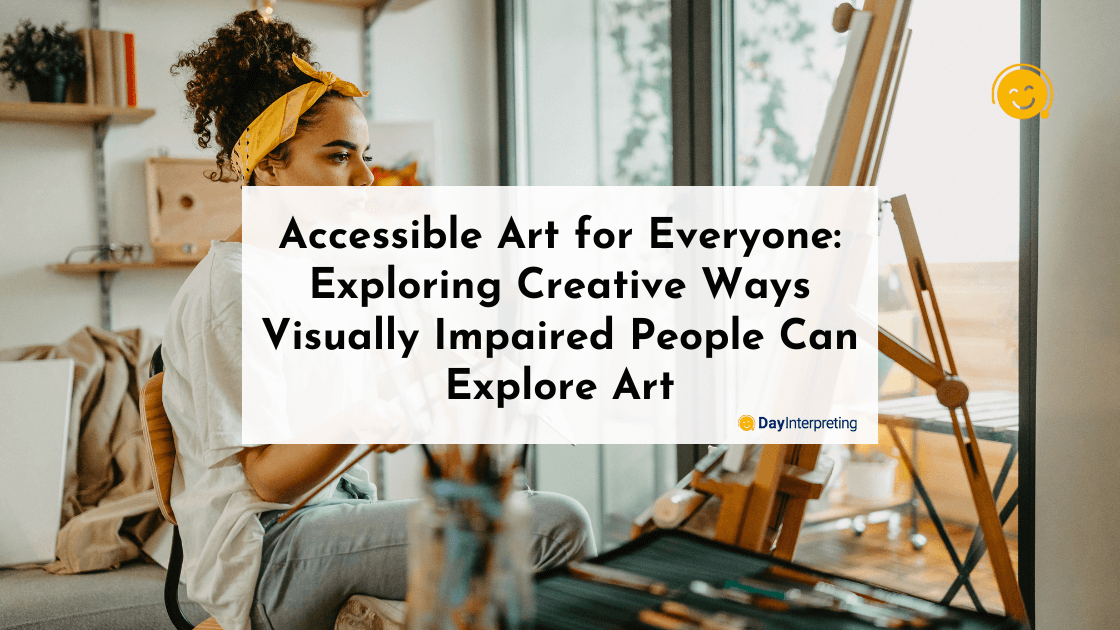The world of art can often be inaccessible to those with visual impairments, but it doesn’t have to be this way. At its core, art is all about interpreting the world around us creatively, and it should be open to everyone regardless of ability. And this is where accessible art comes in.
In this blog post, we’ll be exploring different ways of making art more accessible to visually impaired people and how they can experience it in a way that’s meaningful to them. By increasing accessibility and providing alternate methods of interpreting art, we can ensure that everyone has the opportunity to appreciate and enjoy it.
What is Accessible Art?
Accessible art is the practice of making artwork more accessible to visually impaired people through creativity and thoughtful interpreting services. This includes, but is not limited to, providing appropriate signage, special audio-visual equipment, or the use of an Art Interpreter. Accessible art strives to allow everyone to experience and appreciate art regardless of their visual capabilities.
The concept of accessible art involves interpreting art for those who cannot see it traditionally. The goal is to provide an alternative method of interpreting art in order to create a more inclusive and enjoyable experience. For example, an Art Interpreter may offer verbal descriptions of artwork, tactile models, audio recordings, or other creative ways of helping a visually impaired person appreciate the art. By providing multiple opportunities for interpretation, the visually impaired are able to enjoy the same art that is available to all viewers.
Paint by numbers kits have gained popularity among adults as an effective way to make the process of creating art more approachable and enjoyable. Platforms like Canvas By Numbers offer high-quality paint-by-numbers kits designed for beginners and experienced artists alike, empowering individuals to express themselves creatively, regardless of prior experience or ability. These accessible DIY kits can be a great resource for those looking to explore painting in a supportive, guided environment – making art truly available to everyone.
How can Art be Made Accessible for Visually Impaired People?
Visually impaired people can still appreciate art in a meaningful and creative way, thanks to the creative approaches being developed today. One of the most important ways art can be made accessible for the visually impaired is through interpreting services. Interpreting art for people with vision loss involves communicating the artwork’s meaning in a way that can be understood by all individuals, regardless of their visual abilities.
Interpreting art for the visually impaired requires creativity and often involves more than just verbal description. For example, tactile and audio tours of a museum may be used, as well as audio descriptions of works of art and 3D printing of sculptures. With these tools, visitors with vision loss can get a sense of the artwork’s size, shape, texture, and other characteristics. It is also important to provide visually impaired visitors with appropriate materials in advance, such as a large print or Braille guide, so they can gain an understanding of the artwork before they enter the museum.
What are Some Benefits of Accessible Art?
Making art more accessible allows those with visual impairments to experience and appreciate the same pieces of art that sighted people take for granted. This type of access helps break down barriers between those with and without visual impairments, increasing inclusion and education opportunities.
Tactile exploration of art encourages more physical interaction with art, allowing individuals to feel the texture and materials used in a sculpture or painting.
For individuals with visual impairments, accessing art can be an emotional experience as well. Many visually impaired people find that when they are able to engage in art through touch, they become even more connected to the piece, feeling inspired and energized by the creative process.
Ultimately, accessible art provides an inclusive experience for all. By making art more accessible for those with visual impairments, we can open up a world of possibilities and give everyone the opportunity to appreciate and enjoy works of art.
How To Get Involved in Making Art Accessible
There are a variety of ways to get involved in making art more accessible, from volunteering to providing interpreting services.
Volunteering with organizations dedicated to providing art experiences for the visually impaired is a great way to get involved. Organizations such as Day Translations Social Impact often provide training on how to create tactile art, use low-vision-friendly materials, and provide other resources to ensure that visually impaired people can enjoy art.
Another way to get involved is by providing interpreting services.
Interpreting services involve creating audio descriptions of artwork so that blind and low-vision individuals can experience it. This involves researching the artwork and the artist, understanding the context of the artwork, and then translating this into a verbal description. This ensures that the artwork can be appreciated by those who cannot view it directly.
Finally, advocating for accessible art can help bring attention to the need for artwork to be accessible to all. Share resources online, contact museums and galleries about creating accessible art, and encourage friends and family to think about ways to make art more accessible for everyone. By increasing awareness about accessible art, we can work together to create more meaningful experiences for visually impaired people.
How an Art Interpreter can Help in Making the Arts Accessible
When it comes to making art more accessible for visually impaired people, art interpreters can be a great asset. Art interpreting services are a way to bridge the gap between the artist and their audience, allowing visually impaired people to have an in-depth understanding of the work of art.
An art interpreter has specialized skills that allow them to interpret artwork for those with visual impairments. This includes providing verbal descriptions of artwork, allowing the listener to gain a better understanding of what is being portrayed. Additionally, they can provide tactile experiences, using materials such as clay, paint, paper and fabric to help the listener feel a sense of the artwork. Art interpreting services also provide an opportunity for people with visual impairments to engage in dialogue with the interpreter, enabling them to ask questions and gain further insight into the artwork.
The benefits of having an art interpreter to help provide interpretation services are numerous. Not only do they help make art more accessible to visually impaired people, but they also open up opportunities for education and appreciation. An art interpreter can provide insight into the cultural and historical context of a piece of artwork. This helps those with visual impairments to gain a deeper understanding of the artwork. Furthermore, having an art interpreter help interpret art provides a safe and comfortable space for visually impaired people to explore the artwork in a way that suits their individual needs.
By utilizing the expertise of an art interpreter, everyone has the chance to enjoy and appreciate art regardless of any visual impairments. Art interpreting services can play an important role in making art accessible for all.





0 Comments